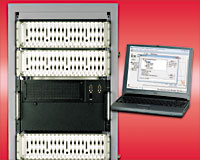
Sensor Signal Conditioning for High Channel Counts
Data Acquisition System Eliminates All Aliasing
NEWS FOR IMMEDIATE RELEASE |
|---|
|
For more information, contact |
Bellevue, WA, March 28, 2007 -- Microstar Laboratories, Inc., maker of Data Acquisition Processor (DAP) boards, today announced sensor signal conditioning packages with data acquisition systems that eliminate all aliasing from sampling and that scale up to acquire data for applications with hundreds of inputs. This results from the synergy of three products: first, DAPcell to synchronize data acquisition on networked PCs to within a few nanoseconds, second, iDSC 1816 boards – specialized DAPs that include analog and digital filters – inside each PC, and third, SCS (Signal Conditioning System) packages in standard industrial enclosures.
DAPcell
DAPcell network software allows any or all PCs on a network to run DAPcell server software to handle requests for data acquisition services provided by the DAPs on those PCs. Requests for those services come from DAPcell client software on those PCs or on any other PCs on the network. This technology avoids network limitations on performance. For instance, a request for high-speed logging to disk can originate anywhere on the network but typically specifies that the DAPcell server software transfers data to a disk on the same PC: the one containing the DAP that acquires the data. A hardware option distributes clock signals that allow DAPcell to synchronize sampling across all servers on the network to within a few nanoseconds.
iDSC 1816 Board
The iDSC 1816 board – a specialized DAP with programmable onboard filter circuits – combines 16-bit resolution on eight simultaneous channels of data acquisition with brick-wall anti-alias filters on each channel. The iDSC 1816 samples analog inputs at a throughput of 1.2M samples per second, with a sampling rate on each channel that can range from 8 samples per second to 153.6k samples per second. The data stream optionally includes an additional 300k samples per second: information from one or two external timing channels. Software can parse the data stream to correlate the analog data with events on one or both of the timing channels, to a resolution of 51 nanoseconds.
DAPstudio, a Windows measurement-software application, includes a filter-design option that displays the filter-response curve in real time as you move onscreen sliders to customize the filter on each channel. You can download DAPstudio from the Web to check it out for yourself.
SCS (Signal Conditioning System) Packages
An SCS package provides direct connection to sensors, and offers many signal-conditioning services in a single convenient, powerful package. These include
- current sensor excitation: 4 mA at up to 28 Volts
- voltage sensor excitation: 1, 2, 5, and 10 Volts at up to 70 mA
- quarter-, half-, and full-bridge resistor networks
- 120 and 350 ohm resistors as standard options
- any value resistor networks, sensor by sensor
- 10 full-scale options: 10 mV, 20 mV, 50 mV, 100 mV, 200 mV, 500 mV; 1, 2, 5, and 10 V
- available offset ranges from between +/-0.5V to +/-5V, depending on input option range used
- programmable gain with auto-calibration
- programmable AC/DC coupling for ICP sensors
- two high-resolution acquisition-synchronized timing channels per module
Each SCS package consists of an MSIE standard industrial enclosure containing 1, 2, 3, or 4 modules. Each module connects to an iDSC 1816 contained in a PC and provides it with eight conditioned analog signals and up to two TTL timing signals. The data stream produced by each iDSC in a PC optionally includes one or two time stamps for each set of eight converted signal samples. The time stamps give the clock count when the iDSC sensed a rising TTL edge during the analog-to-digital conversion process.
Conclusion and Next Step
You can use 8-, 16-, or 32-channel building blocks to generate alias-free synchronized data from raw signals at the sensor in applications that can span hundreds of channels sampled simultaneously. And you can do all this at a very reasonable cost. Contact Microstar Laboratories for more information.
# # #
Editorial Overview:
You now can acquire alias-free synchronized data from raw signals at the sensor in applications that can span hundreds of channels sampled simultaneously. You do this with Signal Conditioning System (SCS) packages, available as 8-, 16-, or 32-channel building blocks, preinstalled in standard industrial enclosures by Microstar Laboratories, Inc., maker of Data Acquisition Processor (DAP) boards. Connect the SCS packages to specialized DAPs with onboard analog and digital filters housed in networked PCs. Additional boards distribute clock signals to other PCs on the network and allow DAP software to synchronize inputs to within a few nanoseconds. For more information, contact Microstar Laboratories.
Note to the Editor:
Microstar Laboratories suggests this text as a caption for either of the available images:
DAPcell synchronizes data acquisition on networked PCs to within a few nanoseconds in this sensor signal-conditioning system package from Microstar Laboratories.
Microstar Laboratories, Inc. claims Microstar Laboratories, Data Acquisition Processor, DAP, iDSC, DAPcell, and DAPstudio as trademarks. Microsoft has registered Windows, Windows XP, and Windows Vista as trademarks. Other organizations may claim – or may have registered – as trademarks any trade names, logos, and service marks that appear in this document but not in the list above.
Microstar Laboratories makes it a practice to use an appropriate symbol at the first occurrence of a trademark or registered trademark name in a document, or to include trademark statements like this with the document.
